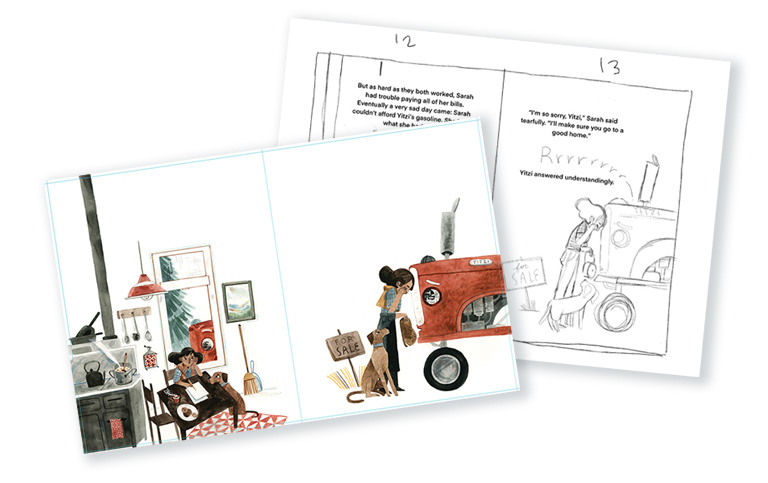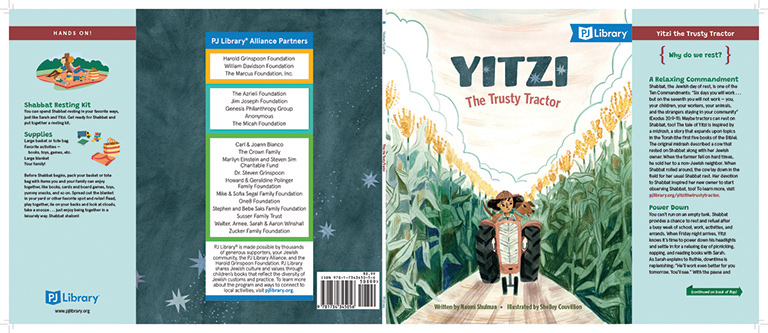How a Book Becomes a Book
By Naomi Shulman
Content and Engagement Officer, PJ Library
PJ Library Author
When those blue-and-white envelopes arrive in mailboxes around the globe, kids everywhere rejoice. But have you ever stopped to think about the journey those books take to get there? It’s more than the mail trucks and cargo ships that transport the books. We’re talking about the long and twisting path from manuscript to bound book!
I have been on the editorial end of this process for years, but recently I got to experience it from the author’s vantage point when my picture book Yitzi the Trusty Tractor was published by PJ Publishing. I asked Samara Klein, publisher of PJ Publishing, to help me identify the landmarks a PJ Publishing book has to hit as it wends its way to your doorstep.
The Muse
Who can say how it happens? An idea strikes, and the author (or author-illustrator!) puts the proverbial pen to paper. In my case, I had read a famous old midrash about Rabbi Yochanan ben Torta and the cow and thought it would be fun to reimagine the story in a contemporary setting.
The Submission
Along with hundreds of authors each year, I submitted my manuscript (anonymously) to the PJ Library Book Selection Committee — and happily, they accepted it. When the book selection committee accepts submissions directly from an author rather than an independent publisher, then PJ Publishing takes a look. And if PJ Publishing likes it …
The Contract
… then the author and publisher execute an agreement, and the fun really begins!
The Plot
Samara works directly with authors to edit and plot out the books. We’re not talking about a story plot; in this case, plotting refers to figuring out what words and art will appear on each page. “Picture books have to be in increments of eight,” Samara explains, which is because of how the pages of books are printed, folded, and bound. “Ours tend to be 24 or 32 pages. We need to reserve some pages for the title page, copyright information, and perhaps some back matter, but the remaining pages are ours to play with. We want the text to be visually represented, and we want it to move very nicely from page to page, to have a nice flow to it. It’s like a puzzle.” She’s right about that — it’s harder than I realized, and she’s a whiz at it.
The Red Pen
Once the pages have been plotted out, it’s time to focus on the details and revise, revise, revise. This part can feel tedious at times, but it’s all to make the book the best it can be. We all need editors, even the most brilliant writers — and of course, PJ Library authors are among the most brilliant writers (ahem). In all seriousness, I could not be more grateful for good editing!
The Art
Some PJ Publishing submissions come from author-illustrators, which means the art is already part of the deal, but my submission didn’t, which is often the case. To help us pick the perfect artist for the book, Samara began pulling illustrator samples to share with me. “Sometimes we’ll have an illustrator in mind from the get-go,” Samara says. “Other times, we’ll look through dozens and dozens of portfolios and illustrator agencies to find the right match.” It didn’t take long for both of us to agree that Shelley Couvillion’s wonderful rustic style was a perfect fit for Yitzi.

The Canvas
One thing I had never thought about was how the book would be shaped: Should it be tall (portrait) or wide (landscape)? Would it have large sweeping pages or be a tiny jewel box of a book? “The physicality of a book has a lot of bearing on the illustrations,” Samara explained to me. Before illustrators begin their work, they need to know what they’re working with.
Sketching
Once that was settled, Shelley began sketching …
Coloring
… and colored in her work …

Design
… and then the art and text were handed off to a designer, who meshed it all together. This is the stage when branding elements are added, along with back-cover and flap copy. But occasionally there are some other fun ingredients added to the mix. “Sometimes we have a book with special stuff,” Samara adds. Some books have pull tabs and lift-the-flap elements that allow readers to interact with books, so this requires a unique process. “We receive a prototype where the printer puts together by hand a blank dummy of what the book will feel like.”
Proofs
The name of this magazine hints at this step — proofs! While proofreaders are involved at several stages along the way, the printer proofs are the last chance to make sure every i is dotted and every t is crossed and that the art looks just like it’s supposed to.
Printing, Packing, and Mailing
Once the proofs are approved and everything looks good, the books are printed, bound, and put into envelopes for shipping. And then …
You’ve Got Mail
… they arrive in mailboxes and on doorsteps around the world, brand-spanking-new. It’s our hope that one day your children will read PJ Library books to their children and maybe even their children’s children. What could be a greater marker of a book’s success?